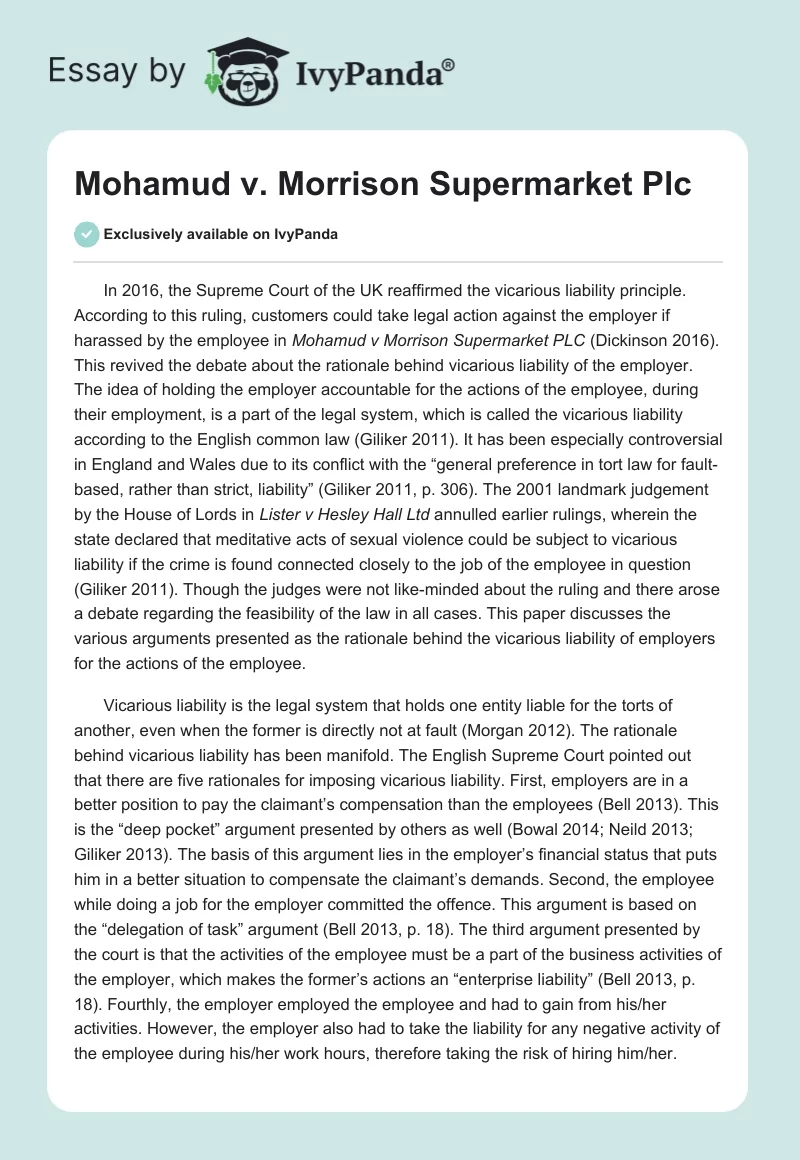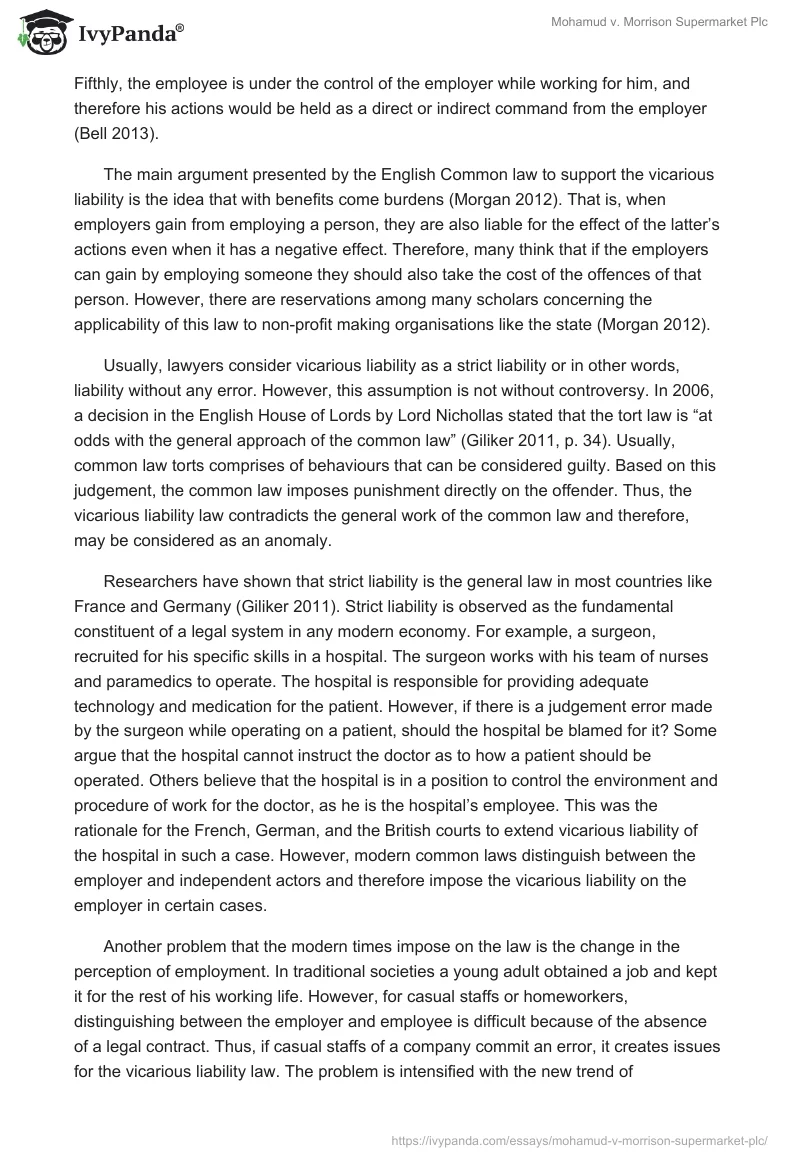In 2016, the Supreme Court of the UK reaffirmed the vicarious liability principle. According to this ruling, customers could take legal action against the employer if harassed by the employee in Mohamud v Morrison Supermarket PLC (Dickinson 2016). This revived the debate about the rationale behind vicarious liability of the employer. The idea of holding the employer accountable for the actions of the employee, during their employment, is a part of the legal system, which is called the vicarious liability according to the English common law (Giliker 2011). It has been especially controversial in England and Wales due to its conflict with the “general preference in tort law for fault-based, rather than strict, liability” (Giliker 2011, p. 306). The 2001 landmark judgement by the House of Lords in Lister v Hesley Hall Ltd annulled earlier rulings, wherein the state declared that meditative acts of sexual violence could be subject to vicarious liability if the crime is found connected closely to the job of the employee in question (Giliker 2011). Though the judges were not like-minded about the ruling and there arose a debate regarding the feasibility of the law in all cases. This paper discusses the various arguments presented as the rationale behind the vicarious liability of employers for the actions of the employee.
Vicarious liability is the legal system that holds one entity liable for the torts of another, even when the former is directly not at fault (Morgan 2012). The rationale behind vicarious liability has been manifold. The English Supreme Court pointed out that there are five rationales for imposing vicarious liability. First, employers are in a better position to pay the claimant’s compensation than the employees (Bell 2013). This is the “deep pocket” argument presented by others as well (Bowal 2014; Neild 2013; Giliker 2013). The basis of this argument lies in the employer’s financial status that puts him in a better situation to compensate the claimant’s demands. Second, the employee while doing a job for the employer committed the offence. This argument is based on the “delegation of task” argument (Bell 2013, p. 18). The third argument presented by the court is that the activities of the employee must be a part of the business activities of the employer, which makes the former’s actions an “enterprise liability” (Bell 2013, p. 18). Fourthly, the employer employed the employee and had to gain from his/her activities. However, the employer also had to take the liability for any negative activity of the employee during his/her work hours, therefore taking the risk of hiring him/her. Fifthly, the employee is under the control of the employer while working for him, and therefore his actions would be held as a direct or indirect command from the employer (Bell 2013).
The main argument presented by the English Common law to support the vicarious liability is the idea that with benefits come burdens (Morgan 2012). That is, when employers gain from employing a person, they are also liable for the effect of the latter’s actions even when it has a negative effect. Therefore, many think that if the employers can gain by employing someone they should also take the cost of the offences of that person. However, there are reservations among many scholars concerning the applicability of this law to non-profit making organisations like the state (Morgan 2012).
Usually, lawyers consider vicarious liability as a strict liability or in other words, liability without any error. However, this assumption is not without controversy. In 2006, a decision in the English House of Lords by Lord Nichollas stated that the tort law is “at odds with the general approach of the common law” (Giliker 2011, p. 34). Usually, common law torts comprises of behaviours that can be considered guilty. Based on this judgement, the common law imposes punishment directly on the offender. Thus, the vicarious liability law contradicts the general work of the common law and therefore, may be considered as an anomaly.
Researchers have shown that strict liability is the general law in most countries like France and Germany (Giliker 2011). Strict liability is observed as the fundamental constituent of a legal system in any modern economy. For example, a surgeon, recruited for his specific skills in a hospital. The surgeon works with his team of nurses and paramedics to operate. The hospital is responsible for providing adequate technology and medication for the patient. However, if there is a judgement error made by the surgeon while operating on a patient, should the hospital be blamed for it? Some argue that the hospital cannot instruct the doctor as to how a patient should be operated. Others believe that the hospital is in a position to control the environment and procedure of work for the doctor, as he is the hospital’s employee. This was the rationale for the French, German, and the British courts to extend vicarious liability of the hospital in such a case. However, modern common laws distinguish between the employer and independent actors and therefore impose the vicarious liability on the employer in certain cases.
Another problem that the modern times impose on the law is the change in the perception of employment. In traditional societies a young adult obtained a job and kept it for the rest of his working life. However, for casual staffs or homeworkers, distinguishing between the employer and employee is difficult because of the absence of a legal contract. Thus, if casual staffs of a company commit an error, it creates issues for the vicarious liability law. The problem is intensified with the new trend of outsourcing. Today, most companies outsource their nonessential departments to other companies. This contracting companies hire employees temporarily on a contract that complicates the situation further. This difficulty was observed in the case of O’Kelly v Trusthouse Forte (Giliker 2011). In this particular English case, the concerned hotel employed a casual worker along with its permanent staff. The English common law did not consider the casual worker as an ‘employee’ because of the absence of a legal employment contract. Therefore, when a guest was burnt due to the casual waiter’s negligence, the issue with liability surfaced. Who will be responsible for the accident – the hotel or the waiter? Such a situation places the victim in a precarious position to identity the right party with financial superiority that may be in a position to compensate for his/her damages. Thus, a more flexible interpretation of the liability law must be adopted to avoid such problems. The German and French lawmakers have adopted such flexibility where the liability falls on the employer who is in a position to influence the decisions of the employee and therefore, must be held liable for the latter’s actions (Giliker 2011). Consequently, the onus of the liability may be extended to the independent contractors and traders. However, the English courts believe that adopting a more flexible interpretation of liability would lead to problems resulting in uncertainty and the risk of an immense increase in liability.
References
Bell, J 2013, ‘The basis of vicarious liability’, The Cambridge Law Journal , vol. 72, no. 1, pp. 17-20.
Bowal, P 2014, Vicarious liability: the legal responsibility of employers. Web.
Dickinson, H 2016, Further developments in the law of vicarious liability – criminal assaults and criminals at work. Web.
Giliker, P 2011, ‘Vicarious liability or liability for the acts of others in tort: a comparative perspective’, Journal of European Tort Law, vol. 2, no. 1, pp. 31-56.
Giliker, P 2013, ‘Vicarious liability ‘on the move’: the English Supreme Court and enterprise liability’, Journal of European Tort Law , vol. 4, no. 3, pp. 306-313.
Morgan, P 2012, ‘Recasting vicarious liability’, The Cambridge Law Journal, vol. 71, no. 3, pp. 615-650.
Neild, D 2013, ‘Vicarious liability and the employment rationale’, Victoria University Wellington Law Review, vol. 44, pp. 707-723.


